It’s been a few months since I’ve done a Homemade Trials and since it’s one of my favorite style of posts that I write these days, I figured it was long overdue.
A month or so ago, I got an email from a reader and blogger friend, Dan, asking me to tackle hummus for a homemade trials. The question was kind of a multi-part one.
First, does it ever make sense to make your own? Is it really cheaper and tastier?
Second, does it matter if you use dry beans or canned beans?
So I set out to compare three styles of hummus in the categories of TIME, NUTRITION, COST, and TASTE. After all of that, we’ll see if we can find a winner!
A Very Basic Hummus
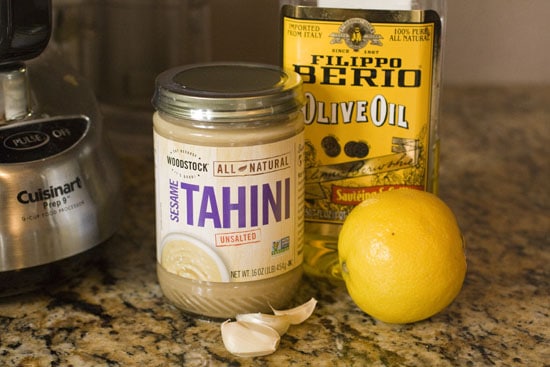
For this trial, I used my favorite store brand of hummus, Sabra. I think it has delicious texture and flavor and knew that it would give me a good run for my hummus.
For the homemade versions, I used a very simple recipe:
Basic Hummus
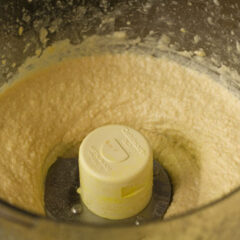
Equipment
Ingredients
- 9 ounces cooked chickpeas, this is one 15 ounce can after you drain out the water
- 3 cloves garlic
- ½ lemon, juice only
- ¼ Cup Tahini
- ¼ Cup olive oil
- ¼ Cup water
- ¾ Teaspoon kosher salt
Instructions
- Combine chickpeas, garlic, lemon, tahini, water, and salt in food processor.
- Turn on food processor. As it runs, drizzle in oil until smooth.
- Serve with pita or crackers.
Nutrition
Did you make this recipe?
I realize that you could spice this up as much as you wanted by adding roasted red peppers, paprika, roasted garlic, or pine nuts, but I just wanted to keep it simple on my end.
Let’s get on with the trials!
TIME
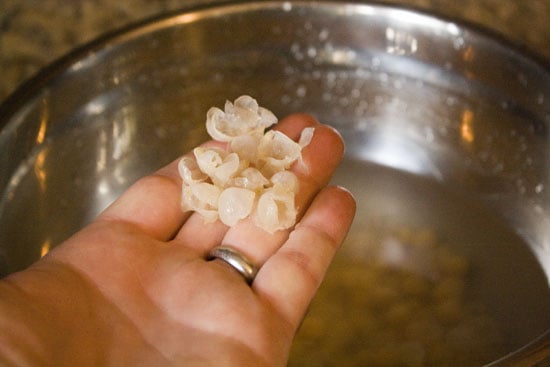
Let’s get the easy trial out of the way first. Obviously, it takes no time to open up a container of Sabra.
It took me about 15 minutes to whip up my hummus using the canned variety. Most of this time was dealing with the chickpeas. If you want a really creamy hummus you have to remove the shells from each chickpea. They rub off pretty easily, but it definitely took me a few minutes to get them mostly cleaned.
Once the shells are off though, it took me just a few minutes to toss everything in a processor and pulse it up.
Meanwhile, the version with dried chickpeas obviously took longer. I had to soak the chickpeas and then simmer them for about 90 minutes. Then I had to shell them and blend them just like the canned version. While this was largely unattended time, it still took awhile.
So TIME goes to store-bought, followed by canned, and dried. No surprises there.
COST
I wasn’t really sure how cost was going to work out. I would think that homemade would be cheaper, but frankly, two of the ingredients that go into hummus (olive oil, tahini) are pretty pricey! It’s possible that it’s cheaper for a company like Sabra to buy them in bulk.
Let’s check out the chart!
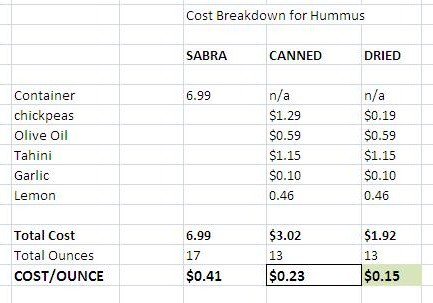
Whoa! That’s an enormous difference in cost. Even though the basic hummus recipe makes less hummus than the Family pack of Sabra hummus, the cost per ounce is WAY down for both the canned and dried version.
The cost difference between canned and dried is what it is because a pound of dried chickpeas cooks up to 48 ounces of cooked chickpeas which can obviously be used to make a lot of hummus.
Just for effect, if you were to eat a container of Sabra per week, you would save $233 over the course of a year by making an equal amount of hummus with dried beans or $160 in savings if you used canned. That’s not shabby.
So cost goes to dried bean hummus followed closely by canned.
NUTRITION
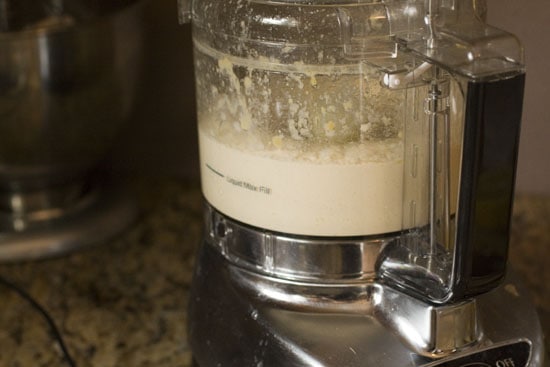
I had no idea how nutrition would play out at all. I figured they would all be pretty similar. Let’s check out the chart and see where we stand!
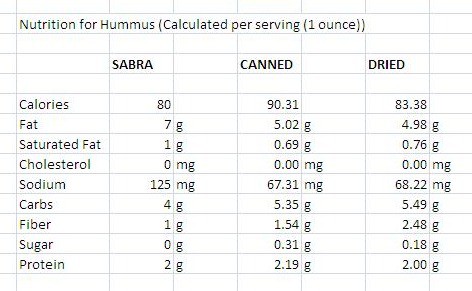
Well, yea. Nothing too exciting. They are all basically the same.
If I had to pick a winner, I would say dried just because it has slightly less fat than Sabra, less sodium, and way more fiber than both (I double checked the fiber cause it seemed weird).
In reality though, this is a tie for nutrition. Hummus is pretty good for you whether you buy it or make it. Go figure.
TASTE
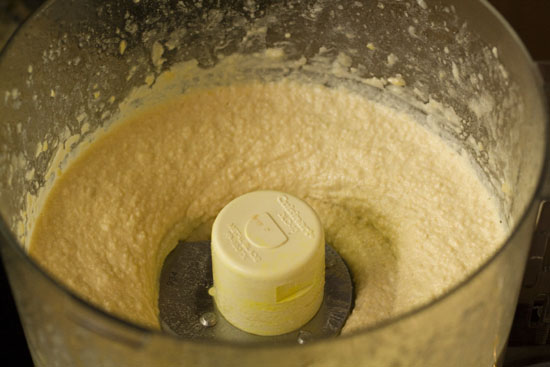
This was the wild card category as always.
I knew I would be biased on this so I called in my official taste-tester: my wife. I lined up each sample and she tasted each version blindly with a chip. These were her results:
Least Favorite: The dried chickpea variety. She said the tahini was over-powering. This couldn’t be due to the actual tahini because there was the same amount in the canned version. She also said the texture wasn’t quite right.
Favorite Flavor: Sabra. This wasn’t a total shock to me. After looking at the ingredients in Sabra, they add a number of spices into even their original flavor. I think if you added some flavors and spices though you could get close.
Favorite Texture: Canned! This was a total shock to me because I always thought Sabra had the best texture. But after peeling the chickpeas, she picked the canned version as the best texture.
I consider texture to be as important as flavor for hummus so I’m calling this one A TIE between canned and Sabra.
CONCLUSION
After all of this analysis, I think there’s one pretty clear conclusion actually. It seems like it is completely worth it to make your own hummus BUT you should used canned and not dried chickpeas unless you are on a very tight budget.
Even though you would save a bit more money by using dried, I think the time difference is enough to swing it over in the favor of canned. Also, it was a lot easier to get a good texture using canned.
With a little practice and some spices, you could easily make a hummus at home that rivals one of the best in the stores for about half the price and a few minutes a week. If you eat a fair amount of hummus, it’s pretty clear that that’s the way to go in my opinion.
What do you think? Are you surprised by the conclusion? Will this influence your shopping?

Nick
Oh and I forgot to mention that if you have any ideas for future Homemade Trials, let me know!
Jul
Hey Nick- I have a question for you, and the readers.
I like hummus, but I don't eat a lot of it. I notice when you buy it at the store the date on the package is usually a month away- which I like because it takes me that long to eat the whole container.
My question is: how long do you think the home made would be good after you make it?
Nick
Hey Jul, I've never tested it to its breaking point, but it should last a few weeks without a problem. There's nothing in hummus that would go bad especially quickly.
Tracy Tomlin Stricklin
I personally like hummus made with dried beans. I overcook them slightly, and they seem to blend better and smoother than canned beans. I do have to plan ahead, which is not one of my strong points. I usually freeze the extra tahini, since it is so expensive.
Brendan
Good point. Hey Nick, how did you cook your chickpeas? Al dente? or overcooked and mushy? For hummus, it seems the latter would actually be better.
texture – when i make it with caned chickpeas, i usually only peel half of them or so and its very creamy (especially with a blender).
taste – well that wasn't exactly a fair comparison, then??
Tracy Tomlin Stricklin
I also use my pressure cooker, as a couple of other people have mentioned as well. Makes it easier to get a mushy bean. I never peel them either, too much work.
Chloe
Great post, Nick. Reminds me to start making more hummus. I'd love to see a veggie burger homemade trial. Veggie burgers can be made so many different ways and can be so good so I'd love to see you stack 'em up against a morningstar or Amy's brand.
Nick
Good idea Chloe! Thanks!
Tammy
I second this suggestion! I'd love to see homemade trials for veggie burgers.
Jessica
I love making my own hummus because you can really play with the flavors and it really does taste fresher to me. I always used canned chickpeas and have have tried the chickpea flour, but I think the canned chickpeas are the way to go. Thanks for doing this, it's one I was actually hoping to see on here as well :)
My recent post Tuesday Reviews-Day
Sarah
I would love to see a homemade trials about condiments! Is it worth making your own ketchup, mayo, mustard, butter, creme fraiche, etc?
September
In my son's preschool they do cooking class twice a week and I was surprised one of the biggest hits this year was when they made hummus! It was a simplified version (couldn't use tahini because of allergies) with just canned chickpeas, lemon juice, garlic and olive oil (with reserved chickpea liquid added back in to thin it out to the right consistency)–those three and four year olds had a blast making it and there wasn't any left over once they attacked it with baby carrots and crackers.
maria
I almost exclusively make my hummus from scratch, except that I use canned beans instead of dried. I've never, ever taken the skins off of the chickpeas before getting them in the food processor and I always get creamy hummus. I probably just let the food processor run for a bit longer than you did. I'm pretty sure that that was an unnecessary step that could have saved you time and added extra fiber to the canned homemade version. Clearly, I'm all for making the homemade/canned version the winner here! :)
kitty
i love these posts — they are some of my favorites! i read through the entire thing even though i don't eat hummus.
Nick
Thanks Kitty! I like writing them also. I'll try to get back into the habit of doing them at least once a month. Sometimes I get easily distracted…
Karen
Great post and wonderful work on the blog. I'm one of your blog-stalkers, Nick, and read your blog everyday. Just wanted to say that I make my own hummus as well and cook my beans in the pressure cooker, which cuts down on the prep time enormously if you choose to use dried beans. I also let the food processor work the beans a long time, which makes everything nice and creamy and eliminates the de-shelling (I'm lazy).
Bev
I've made hummus with canned Northern beans. Texture is smoother-no skins to deal with, my family does not like tahini so we leave it out. It's our new favorite recipe.
Bev
Norma Stedry
Bev, I've had a ton of (dried) Northern beans given to me and thought about making hummus with it. Did you use the above recipe or create one of your own. I love hummus and have a party coming up and would love to have a **good** recipe for it ~ esp to use up all these beans!!!!! Your response would be greatly appreciated. Wellita
Nick
Hey Norma, She might not respond. She doesn't get notified when a reply is posted. In any event though, I think my standard recipe would be fine with white beans… or this one might do the trick: http://www.foodnetwork.com/recipes/george-duran/w…
dan
Nice work man! Glad you used my idea. I kinda expected canned homemade to be the winner, but I wanted someone else to do the legwork to confirm my hypothesis!
My recent post Three Mac and Cheeses for a Ravenous Crowd
Emily
For other homemade trials I would like to recommend pesto and pickles. My mom and I are canning some good polish dills this week, but I’m curious to see how they stack up.
Brendan
Homemade trial with TOMATO SOUP!!!
Brendan
I think the goal with this is to find store-bought winners (since homemade is almost always better). Tomato soup has a chance!
Brendan
Actually really, I guess the goal is to change our habits (mostly to make at home things we buy, but i think its good to know when its actually more worth it to buy it), which makes me like the idea about condiments. obviously homemade mayo would win for you (since u dont like store-bought and its easy to whip up) and prob ketchup too (since you dont like ketchup). personally i always make cocktail sauce, horseradish sauce, and tartar sauce (when i actually use it) from scratch as theyre very easy to make and cheaper/fresher to boot.
i guess the problem with condiments is how often you'll use them. store-bought have preservatives and last a long time. homemade you'd prob have to use em quickly and might end up throwing a lot out (or making smaller batches which is more work/time and more expensive).
i guess the best idea for homemade trials is find stuff where you use the store-bought versions a lot, then ask yourself if it could be worth it to make your own (considering time/effort obvi, since making your own cheese and cured meats and stuff would be cheaper and better tasting, but how much and at what cost? most people don't have the time to regularly make their own cheese and bacon).
Josh
Great post! I'll have to start shelling my canned chickpeas when I make hummus. I've been too lazy to do that in the past, but if the texture is noticeably better…
I vote for a BBQ sauce Homemade trials next. I've tried about a half-dozen different BBQ sauce recipes, and I have yet to find something that beats my favorite store-bought KC style (Sweet Baby Rays). I own a smoker and make pulled pork or brisket about once a month, so it really annoys me that I can't seem to figure out my own BBQ sauce. Everything else I've ever made has either been instantly superior to or at least as good as the store bought version. But BBQ sauce has become my cooking white whale…
CajunNan
I make my own using dried chickpeas and I cook them in a pressure cooker for 45 minutes…no soaking! I have peeled and not peeled the peas and did not notice a difference. The best way to get the texture right is to have a powerful food processor and run it on high for a full 10 minutes. Even slightly under-cooked chickpeas will breakdown under the pressure and your hummus will be light and fluffy.
Shanti
I buy mine from a local family run Greek restaurant because it tastes so much better than normal store bought stuff. And they have like 10 different flavors. Spinach-feta = super yum. Hot pepper = delicous. Gorgonzola-chive = phenomenal. I'm going to count that as "pseduo-homemade." If I ever leave the area and can't buy from them, then I'm going to attempt this homemade hummus.
thecatinthetree
Thanks for sharing this! I have done informal experiments with removing the skins and not, and decided that the difference is not worth the effort of peeling the beans. The other HUGE benefit of using dried beans is avoiding the BPA exposure from the cans!
My recent post Vegan Strawberry Shortcake
domesticitynouveau
I learned from a Lebanese family that a pinch of baking soda in the cooking liquid of dried beans makes all the difference… have to say it is one cooking trick that has changed my world :)
bubbapickle0609
our family loves my homemade hummus, and with the amount we go through in a week (it's our go-to lunch) I definitely save at the register…I bump DOWN my tahini and bump up my lemon (up to 2 lemons)..but them again I'm a fan of sabra's lemon hummus:)
Daktari
I always make my own hummus using canned beans. I wouldn't dream of paying those prices for prepared hummus when mine kicks butt! But I don't shell the beans. Too much trouble for too little difference.
Simone
I actually recently watched a 'Good Eats' Episode where Alton suggests cooking dried chickpeas in a slow cooker for a softer texture (http://www.foodnetwork.com/recipes/alton-brown/hummus-for-real-recipe/index.html).
Perhaps the texture of the dried bean hummus will improve if cooked this way? Either way, I'm sure all varieties are delicious!
Krissy@MakeItNaked
Great post! What about ice cream? Or chocolate chip cookies? or Guacamole?
Ruth
I always make my own hummus because I like knowing exactly what is in it. I use canned and don't take the skins off. My food processor makes short work of the skins. My family's favorite is plain but I really like to add sun-dried tomatoes that have been soaked in olive oil. Yummy!
Christina
I love homemade hummus and make it often. I think it has better texture and flavor than any store-bought brand I have tasted. Plus, it is super easy to whip up and I always have the ingredients on hand.
I was interested to hear your result with the dried beans. I often wondered if using them would taste better or worse but never felt like taking the effort to use them over canned. Now I don't have to!
Funny, I just posted a traditional hummus recipe and I think I am going to go whip some up now for a snack. Great post!
My recent post Traditional Hummus
Trace
I am digging the homemade trials.. for my hummus I use a combination of chickpea and white kidney beans and I use peanut butter instead of tahini.. keeps cost down and makes a big bowl!
Brent
One thing missed is nutritional value, I always believe freshest ingredients in this hummus or anyother food is the best. I still use the closest to scratch items I can muster up. oh, btw guys, black oliives are the bomb in homemade hummus. Just an idea, which I make is a bagel or toasted english muffin with a layer of hummus, avocado slices, sprinkle of onions(optional), Napa lettuce(classified as a lettuce but is a cross between cabbage n lettuce) for crunch, and any mustard for taste. This is an awesome snack/quicky meal for you.
Brendan
You should make your own tahini; it’s way cheaper. You just buy sesame seeds! Lightly toast them and then put them in the food processor (or high-powered blender). You might add a bit olive oil to help it (like making peanut butter… it’s not necessary to add oil, but it’s faster/easier). That will bring the cost down for homemade hummus even more! (you can freeze tahini in ice cube trays easily so I make a big batch when I do it).
Nick
Nice call Brendan! I’ve never doen it but I’m assuming it will keep for a really long time as well. Thanks for the tip!